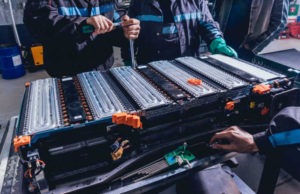
By Roman Zaiets @ Shutterstock.com
Automakers are giving cheaper batteries with shorter ranges a try in their efforts to build electric cars consumers will buy. The Wall Street Journal’s Mike Colias reports:
In the race to build a more affordable electric car, auto makers are turning to a lower-cost battery type that could lead to less-expensive options, but deliver less driving range.
Several major car companies plan to deploy lithium-iron-phosphate batteries, known as LFP, a type commonly used in China, the world’s largest market for electric cars. Those iron-based battery cells cost less than the nickel-and-cobalt combination used widely in North America and Europe.
Tesla Inc., TSLA 4.49%increase; green up pointing triangle Ford Motor Co., F 2.74%increase; green up pointing triangle Rivian Automotive Inc. RIVN 1.31%increase; green up pointing triangle and other auto makers say LFP could tamp down electric-vehicle costs by sidestepping the use of pricey and scarce minerals like nickel and cobalt. But the move also requires them to manage performance trade-offs and thorny supply-chain issues.
Lithium-iron-phosphate battery cells have less energy density than nickel-based cells, which means the battery range—the distance an EV can travel between charges—is shorter. That has led auto makers to tweak the chemistry and the design of LFP battery packs to wring out more range. Also, the supply hub for LFP cells is heavily concentrated in China, leaving auto makers more dependent on Chinese battery supplies at a time when the industry is trying to wean itself from dependence on China for EV technology.
Global auto makers are honing their battery strategies as they spend billions of dollars to put more electric vehicles in showrooms. In many cases, they are revising plans in relatively short periods in response to changes in mineral prices, battery technology and government policy, testing the agility of an industry accustomed to vehicle-development cycles that can span many years.
Rivian, for instance, is moving to LFP battery cells for some trucks, SUVs and vans, after supply-chain snarls crimped production earlier this year, and cobalt and nickel prices shot up.
“We’re quite bullish on LFP,” said Rivian Chief Executive RJ Scaringe, on the company’s earnings call this past Wednesday. He added that the cell type does well in applications where the driver is frequently recharging the vehicle and in roomier models that have the space for a bigger pack.
A few years ago, analysts and executives figured the lithium-iron-phosphate chemistry would mostly be used for low- and moderate-priced EVs in China, where drivers, clustered in dense cities, generally travel shorter distances. In Europe, and especially North America, the strategy was to use the more expensive nickel-and-cobalt-based chemistries to offer the longer range needed to cover populations that are more spread out.
The calculus has since shifted. Auto executives have said interest in LFP batteries has grown after prices soared this past spring following the invasion of Ukraine by Russia, a large supplier of high-grade nickel used in batteries. While they have retreated from their highs, prices remain elevated, making iron-based cells a relative bargain.
Read more here.
